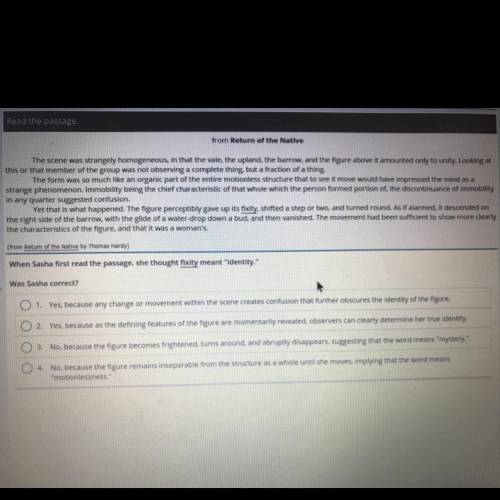
From Return of the Native
The scene was strangely homogeneous, in that the vale, the upland, the barrow, and the figure above it amounted only to unity. Looking at
this or that member of the group was not observing a complete thing, but a fraction of a thing.
The form was so much like an organic part of the entire motionless structure that to see it move would have impressed the mind as a
strange phenomenon Immobility being the chief characteristic of that whole which the person formed portion of the discontinuance of immobility
in any quarter suggested confusion
Yet that is what happened. The figure perceptibly gave up its fixity, shifted a step or two, and turned round. As if alarmed, it descended on
the right side of the barrow, with the glide of a water-drop
down a bud, and then vanished. The movement had been sufficient to show more clearly
the characteristics of the figure, and that it was a woman's.
(from Return of the Native by Thomas Hardy)
When Sasha first read the passage, she thought fixity meant "identity."
Was Sasha correct?
1. Yes, because any change or movement within the scene creates confusion that further obscures the identity of the figure.
2. Yes, because as the defining features of the figure are momentarily revealed, observers can clearly determine her true identity
3. No, because the figure becomes frightened, turns around, and abruptly disappears, suggesting that the word means "mystery"
4. No, because the figure remains inseparable from the structure as a whole until she moves, implying that the word means
"motionlessness.
My


Answers: 1


Another question on English

English, 22.06.2019 03:30
Read this passage from an analysis essay: allegories do three things. first, they tell a story. allegories also have multiple meanings. finally, allegories offer a moral lesson. which best uses parallelism to revise this passage? a. telling a story, having multiple meanings, and moral lessons: these are the things allegories do. b. allegories, tell a story, multiple meanings, and a moral lesson. c. allegories tell a story, have multiple meanings, and offer a moral lesson. d. allegories tell a story, and have multiple meanings and offer a moral lesson.2b2t
Answers: 1

English, 22.06.2019 04:30
In at least 150 words, explain the symbolism of the quilt in “everyday use.”
Answers: 1

English, 22.06.2019 08:30
Which question does the adjective in bold answer? it takes less effort to write essays than you might think. a. how many? b. how much? c. what kind? d. which one?
Answers: 2

English, 22.06.2019 09:30
What is the main source of irony in this poem? -the idea that winning is really losing -the idea that failures hold success in higher esteem than those who are successful -the idea that dying is winning
Answers: 2
You know the right answer?
From Return of the Native
The scene was strangely homogeneous, in that the vale, the upland, the ba...
Questions


Chemistry, 31.03.2020 02:16




Mathematics, 31.03.2020 02:16





English, 31.03.2020 02:16

History, 31.03.2020 02:16




Mathematics, 31.03.2020 02:16

Computers and Technology, 31.03.2020 02:16





